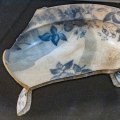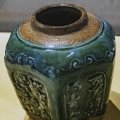Maritime Museum (Galle): photo 15
Photo 15 of 63 in Gallery: Maritime Museum (Galle)

Image title: Earthenware Urn
Description of the photo
English text:
Large Earthenware Urn — Large urns like the present vessel were used in order to store liquids and food stuffs by the Ships of the Dutch East Indian Company which sailed in the Indian Ocean. Such vessels had been produced either in China or Japan during the 17th Century CE.
Sinhala text (not proofread):
විශාල මැටි බරණිය — මෙම මැටි බරණිය ක්රිස්තු වර්ෂයෙන් 17 වන සියවසට අයත් වූවකි. විශේෂයෙන් පෙරදිග ඉන්දීය වෙළඳ සමාගමට අයත් ඉන්දීය සාගරයේ යාත්රා කළ නැව්වල දියර වර්ග හෝ ආහාර ගබඩා කිරිමට මෙවැනි භාජන භාවිත කොට තිබේ. මෙවැනි බඳුන්වලට චීන හෝ ජපන් ප්රභවයක් ඇතැයි සැලකේ.
Transcription:
viśāla mæṭi baraṇiya — mema mæṭi baraṇiya kristu varṣayen 17 vana siyavasaṭa ayat vūvaki. viśēṣayen peradiga indīya veḷanda samāgamaṭa ayat indīya sāgarayē yātrā kaḷa nævvala diyara varga hō āhāra gabaḍā kirimaṭa mevæni bhājana bhāvita koṭa tibē. mevæni bandunvalaṭa chīna hō japan prabhavayak ætæyi sælakē.
Transcription:
vishala mati baraniya — mema mati baraniya kristu varshayen 17 vana siyavasata ayat vuvaki. visheshayen peradiga indiya velanda samagamata ayat indiya sagaraye yatra kala navvala diyara varga ho ahara gabada kirimata mevani bhajana bhavita kota tibe. mevani bandunvalata china ho japan prabhavayak atayi salake.
Automated translation (not verified):
Large clay baraniya — This clay baraniya belongs to the 17th century AD. These vessels have been used to store liquids or food, especially in the ships that sailed in the Indian Ocean belonging to the East India Trading Company. These vases are thought to have a Chinese or Japanese origin.
Tamil text (not proofread):
பெரிய மண்சாடி — இந்து சமுத்திரத்தில் பயணம் செய்த ஒல்லாந்து, கிழக்கிந்திய நிறுவனத்தின் கப்பல்களில் இவ் மண்சாடி போன்ற பெரும் சாடிகளில் உணவு வகைகளை, மற்றும் திரவங்களை சேகரித்து வைப்பதற்காக பயன்படுத்தப்பட்டன. கி.பி 17ம் நூற்றாண்டில் சீனாவில் அல்லது ஜப்பானில் இவ்வகையான சாடிகள் தயாரிக்கப்பட்டுள்ளது.
Transcription:
periya maṇcāṭi — intu camuttirattil payaṇam ceyta ollāntu, kiḻakkintiya niṟuvaṉattiṉ kappalkaḷil iv maṇcāṭi pōṉṟa perum cāṭikaḷil uṇavu vakaikaḷai, maṟṟum tiravaṅkaḷai cēkarittu vaippataṟkāka payaṉpaṭuttappaṭṭaṉa. ki.pi 17m nūṟṟāṇṭil cīṉāvil allatu jappāṉil ivvakaiyāṉa cāṭikaḷ tayārikkappaṭṭuḷḷatu.
Transcription:
periya mansadi — inthu samuthirathil payanam seytha ollanthu, kizhakkinthiya niruvanathin kappalkalil iv mansadi ponra perum sadigalil unavu vagaigalai, marrum thiravangalai segarithu vaippatharkaga payanpaduthappattana. ki.pi 17m nurrandil sinavil allathu jappanil ivvagaiyana sadigal thayarikkappattullathu.
Automated translation (not verified):
Large Manchadi — Large caskets like this one were used in Dutch and East India Company ships that sailed in the Indian Ocean to store food and liquids. These types of sadis were made in China or Japan in the 17th century AD.
Gallery information:
These photos were taken at the Maritime Museum in Galle (Sri Lanka) which include objects recovered from the 2nd century B.C. Godawaya shipwreck. The Maritime Museum is housed in Galle's historic Dutch warehouse (built in 1671) and opened its doors on May 9, 1992. The Maritime Archaeology Museum is serving as a centre of education for various groups of visitors and researchers of Southern region of Sri Lanka.
Photo details:
Date: 2023-09-17
Camera: SONY ILCE-6400
Exposure: 1/15
Aperture: f/4
ISO: 6400
Focal length: 24mm
High resolution:
Download file
Size: 1.43 MB
Resolution: 1375 x 1500
© Copyright: see gallery source

